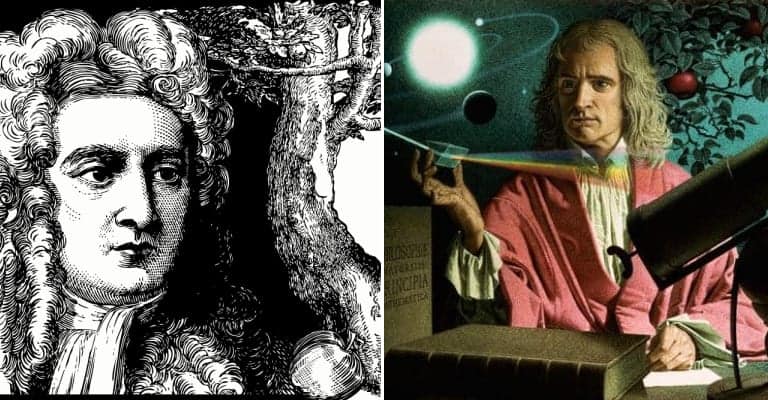

Portrait of a young Isaac Newton (1689), at the time of his great contributions to science. He was the first who managed to explain Nature with a few mathematical equations, and not just words. Later everything was exaggerated, but what is true is that Newton was inspired by everyday events to come up with some simple formulas to describe the motion of anything he saw. He was already quite old when he recounted that upon seeing an apple fall, he realized that the gravity that attracts fruit to the ground is the same force that keeps the Moon orbiting the Earth. But it was he himself who fed the legend. He was knighted by Queen Anne in 1705 and he spent the last three decades of his life in London, serving as Warden (1696–1700) and Master (1700–1727) of the Royal Mint, as well as president of the Royal Society (1703–1727).We all know Isaac Newton for something that he never did: discovering gravity when an apple fell on his head and woke him up from a nap under a tree. Politically and personally tied to the Whig party, Newton served two brief terms as Member of Parliament for the University of Cambridge, in 1689––02. Beyond his work on the mathematical sciences, Newton dedicated much of his time to the study of alchemy and biblical chronology, but most of his work in those areas remained unpublished until long after his death. He was a devout but unorthodox Christian, who privately rejected the doctrine of the Trinity and who, unusually for a member of the Cambridge faculty of the day, refused to take holy orders in the Church of England.

Newton was a fellow of Trinity College and the second Lucasian Professor of Mathematics at the University of Cambridge. In addition to his work on calculus, as a mathematician Newton contributed to the study of power series, generalised the binomial theorem to non-integer exponents, developed a method for approximating the roots of a function, and classified most of the cubic plane curves. He also formulated an empirical law of cooling, made the first theoretical calculation of the speed of sound, and introduced the notion of a Newtonian fluid. Newton's work on light was collected in his highly influential book Opticks, first published in 1704. Newton also built the first practical reflecting telescope and developed a sophisticated theory of colour based on the observation that a prism decomposes white light into the colours of the visible spectrum. Newton's theoretical prediction that the Earth is shaped as an oblate spheroid was later vindicated by the geodetic measurements of Maupertuis, La Condamine, and others, thus convincing most Continental European scientists of the superiority of Newtonian mechanics over the earlier system of Descartes. By deriving Kepler's laws of planetary motion from his mathematical description of gravity, and using the same principles to account for the trajectories of comets, the tides, the precession of the equinoxes, and other phenomena, Newton removed the last doubts about the validity of the heliocentric model of the Solar System and demonstrated that the motion of objects on Earth and of celestial bodies could be accounted for by the same principles. Newton's Principia formulated the laws of motion and universal gravitation that dominated scientists' view of the physical universe for the next three centuries. Newton also made seminal contributions to optics, and he shares credit with Gottfried Wilhelm Leibniz for developing the infinitesimal calculus. His book Philosophiæ Naturalis Principia Mathematica ("Mathematical Principles of Natural Philosophy"), first published in 1687, laid the foundations of classical mechanics. Sir Isaac Newton PRS FRS (25 December 1642 – 20 March 1726/27) was an English mathematician, astronomer, and physicist (described in his own day as a "natural philosopher") who is widely recognised as one of the most influential scientists of all time and a key figure in the scientific revolution.


 0 kommentar(er)
0 kommentar(er)
